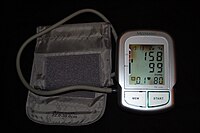
Photo from wikipedia
Objective: To specify prognostic criteria in patients with first grade arterial hypertension for real clinical practice. Design and method: In 66 patients with first grade arterial hypertension office blood pressure… Click to show full abstract
Objective: To specify prognostic criteria in patients with first grade arterial hypertension for real clinical practice. Design and method: In 66 patients with first grade arterial hypertension office blood pressure measurement and ambulatory blood pressure monitoring were done twice with 71,3 ± 1,5 months interval. Initial investigation includes cholesterol, triglycerides, creatinine and uric acid assessment; fasting and postprandial glucose and insulin level measurement, fasting and postprandial heart rate and heart rate variability calculation. After initial examination proper antihypertensive treatment was prescribed to all patients. During period between first and second visits patients were not observed by investigator, depending on their own choice they attended different medical specialists or didn’t visit doctors. Treatment adherence was assessed at the final visit by investigator. Results: Office (149,2 ± 2,0 / 93,5 ± 1,2 mmHg vs 141,3 ± 1,5 / 88,5 ± 1,0 mmHg, p < 0,001) and 24-hours (146,3 ± 2,5 / 89,8 ± 1,8 mmHg vs 132,5 ± 2,6 / 80,8 ± 1,6 mmHg, p < 0,001) blood pressure levels in majority of patients were lower at the final than initial visit. Negative results (higher blood pressure at the final visit, myocardial infarction, unstable angina or sudden death within period between first and second visits) were detected in 11 patients (91% with high or very high total cardiovascular risk). In these patients initially were detected higher fasting (28,5 ± 21,2 mcU/ml vs 15,4 ± 6,2 mcU/ml, p < 0,05) and postprandial (56,0 ± 40,6 mcU/ml vs 21,4 ± 14,6 mcU/ml, p < 0,05) insulin concentration and faster postprandial (88,0 ± 10,2 bpm vs 72,5 ± 8,8 bpm, p < 0,01) and fasting (85,2 ± 13,3 bpm vs 67,7 ± 8,1 bpm, p < 0,01) heart rate than in others. Negative results were detected in 78% of patients with high or very high total cardiovascular risk and heart rate greater than 80 bpm. In the observation period irregular antihypertensive pharmacotherapy was revealed in 70% of patients with negative results and 36% of other participants (p < 0,05). Physical activity reduction was detected in 60% of persons with negative result and 23% of others. Conclusions: Unfavorable prognostic factors in patients with first grade arterial hypertension in real clinical conditions include high or very high total cardiovascular risk, tachycardia, hyperinsulinemia and poor treatment adherence (irregular antihypertensive therapy, low physical activity level).
Journal Title: Journal of Hypertension
Year Published: 2018
Link to full text (if available)
Share on Social Media: Sign Up to like & get
recommendations!